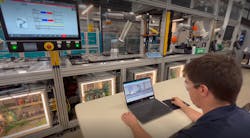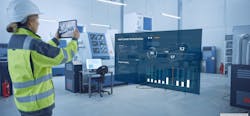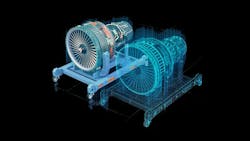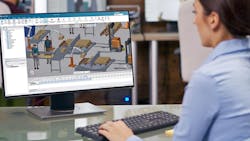A higher form of simulation, digital twins collect data to create accurate simulations that display the operation, potential failures, and possible future maintenance issues in manufacturing equipment and systems. The key difference between a digital twin and a simulation is that the digital twin incorporates live data input from the equipment is represents into its simulation to create a true-to-life representation.
This facet of digital twins is why the technology is rapidly becoming an essential tool for manufacturers. The ability to run, test and optimize a complex, expensive system prior to use saves time and money and can avert failures, damage and employee injuries.
Examining the differences
Though they are similar in concept, simulation and digital twins differ in their objectives. Software-based and often used for training purposes, simulations use models of a process or system that mimic real-world behavior. This enables users to make decisions about a design and changes if necessary.
While simulations primarily target design and training applications, digital twins are often used to simulate the entire lifecycle of a process or system in real time through the design stage, operation, changes and modification as well as commissioning, and decommissioning.
“The digital transformation journey of any manufacturer will require them to work toward a comprehensive digital twin for products, systems and the entire production process,” said Josh Carlson, technical product manager for robotics and automation at Siemens Digital Industries Software. “The comprehensive digital twin allows manufacturers to validate systems before building the physical system to improve production quality and reduce downtime.”
Explaining further, Carlson said he would “argue that simulation is an essential component in digital transformation and critical to leveraging the full capabilities of the comprehensive digital twin. But the comprehensive digital twin is much more. It is a model that can more closely mimic the real thing due to physics, behavior and logic modeling. Simulation is then employed to bring the digital twin to life, to exercise it, analyze it and use it to get answers and make decisions.”
Thomas Muth, strategic business development director for Dassault Systemes-Delmia sees the key differences between simulation and digital twin coming down across several areas:
- Scope—simulation uses predefined sets of variables versus digital twins which are adjustable for any number of variables entering the equation.
- Data Integration—Simulation uses static, predetermined setup variables while a dynamic digital twin will have real-time updates to adjust for real-world events.
- Model—Digital twins require multi-layered models that mimic real-world resources. The key is to have a solid model where multiple scenarios can be interacted with. Simulation is predefined and built specific to a target scenario.
- Lifecycle—Digital twins maintain a continuous relationship with their physical counterparts throughout the lifecycle from design through production and after delivery. Simulations, often used for specific scenarios, may not persist throughout the entire lifecycle.
- Collaboration—The digital twin should allow all stakeholders to collaborate and exchange relevant information within the same interface, whereas simulations are fairly one-dimensional and non-collaborative.
- Use cases—Digital twin use cases are much more diverse, dynamic and role-based than simulations and include asset management, predictive maintenance as well as process and supply optimization.
Which to choose
Giving the differences and overlaps between the technologies, how should industry professionals choose one method for commissioning and/or testing a new or upgraded process?
Carlson said, “It depends on the scope and benefit. For some businesses or markets that are not fast changing or overly complex, simulation may be appropriate if it’s a one-off or if change happens on very long cycles. An OEM or integrator may want to use a digital twin if the product, processes and resources are often subject to change.”
Muth added that OEMs and integrators may already use isolated simulation tools to estimate cycle times, perform equipment layout planning, size hardware, and build and test HMI operator screens.
“These tools drive value early in the planning and design phases but become limited during commissioning,” he said. “One of the most critical and challenging aspects for manufacturers and integrators is the successful combination and integration of different technologies and systems. This becomes most apparent during the commissioning phase and it’s where costs can increase when adjustments are necessary. Called virtual commissioning, a comprehensive digital twin allows virual testing and validation before any designs are final.”
Because virtual commissioning is a dynamic, real-time connection between a comprehensive digital twin of the production system, automation technology and controls, Muth said manufacturers can leverage software in the loop (virtual) or hardware (virtual and physical hardware) during virtual commissioning.
“Shifting the testing and validation to the digital world is much less costly than catching problems on the floor during onsite commissioning and reduces overall commissioning time,” he said.
Diversity of the twins
Due to their ability to connect physical and virtual worlds in real time, digital twins can validate and optimize designs, commission equipment, and validate processes, production, maintenance and supply chains.
According to Muth, this means there are a number of potential digital twin types, but most fall into one of three categories:
- Plant and resource: Twins that simulate the design and layout of new or existing facilities.
- Product and process: Twins that simulate production operations to validate best practices, simulate operation of robots and other shop floor resources, simulate the flow of products and materials, and define and validate process plans and virtual builds.
- Supply chain and operations: Twins that simulate all aspects of the supply chain to optimize the flow of materials to and from the plant.
Carlson contends that the comprehensive digital twin is the best option in all cases. He believes the main advantage to using a comprehensive digital twin is the potential to seamlessly integrate a product within the manufacturing process. He explains, “The digital replica of the product could represent a subassembly like a servo motor or a more complex product such as an entire vehicle. Where the digital representation of production accurately describes the manufacturing processes necessary to make the product, the comprehensive digital twin approach integrates all necessary components.”
Manufacturing applications
Though digital twins have been in use for several years, with industry’s digital transformation underway, the use of digital twins is escalating. “Automotive OEMs, integrators and line builders are leading the way in using digital twins for production and virtual commissioning,” said Carlson, adding that many automotive manufacturers have standardized on Siemens Tecnomatix Process Simulate for the digital twin of their production operations.
“Automotive OEMs, integrators and line builders are leading the way in using digital twins for production and virtual commissioning,” said Carlson, adding that many automotive manufacturers have standardized on Siemens Tecnomatix Process Simulate for the digital twin of their production operations.
Digital twins can help evaluate upgrades to existing equipment, plan a new line and validate changes before releasing items to production. Carlson said, “The push for flexible manufacturing lines—multiple vehicles produced on a single line—and the increasing demand to repurpose existing equipment is making digital twin technology essential for the automotive industry. BMW, Ingemat, Valiant TMS and Wipro Pari are some of the customers using Siemens Tecnomatix digital twin technology.”
“There are benefits for any industry implementing digital twin technology,” Muth said, “but we see the most significant benefits in companies that produce complex products and those in fast growing and changing industries.”
He cited two specific examples:
- A large aircraft manufacturer created a virtual digital twin of its manufacturing line for helicopters. It simulates production machinery in 3D and updates in real-time to monitor production changes.
- A global automotive technology provider deploys virtual digital twin technology to simulate global production processes. This allows the company to plan processes by analyzing sequences and the time spent on each operation. This digital factory enables the company to ramp-up more efficiently, reduce production start-up costs, and harness resources and best practices to better collaborate with a standardized work tool to improve communication inside and outside the factory.
Pros and cons
On the surface, digital twin and simulation technologies have no real cons, just the differences that make each viable for different applications.
“I don’t see any real drawbacks of the digital twin if implemented correctly,” Muth said, “but there are definitely risks to consider in the process.”
Two potential risks Muth identified are: isolated/standalone digital twins and single-purpose digital twins.
Of isolated and standalone digital twins, Muth explained, “For maximum effectiveness, digital twins should be able to connect to and work with other digital twins. A key trend, interconnected digital twins, addresses this.”
Muth said interconnected digital twins provide benefits to the broadest possible audience by enabling the use and commercialization of vast amounts of heterogeneous data, establishing cross-company data spaces and the ability to share data based on cross-company standards.
As for single-purpose digital twins, creating digital twins with too narrow a focus minimizes the value of the digital twin, sometimes to the point where the cost of implementation outweighs the receivable value, Muth said.
Josh Carlson added that he sees no disadvantages when working toward a comprehensive digital twin and leveraging virtual commissioning technology. However, there are strategic aspects that require weighing, such as the necessary competencies to build a digital twin or the internal processes that may require change to support digital transformation.
“The manufacturer must consider the availability of talent to adopt the technology and drive the internal process as well as the methods to upgrade the skills of current employees,” said Carlson. “Not all manufacturers and industries are at the same stage of their digital transformation, just as not all are at the same stage of robotics and automation.”





